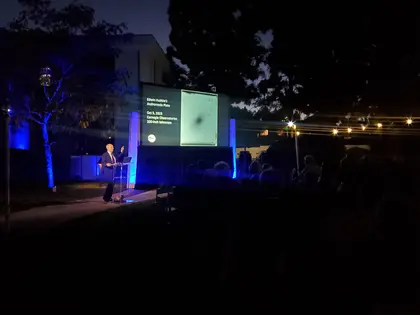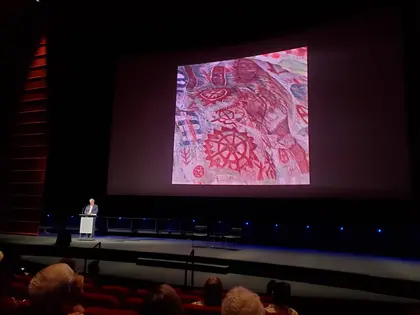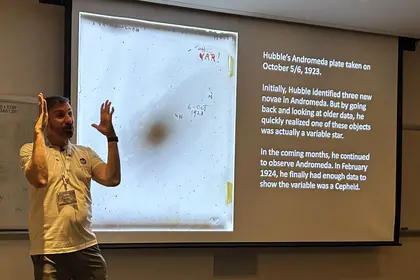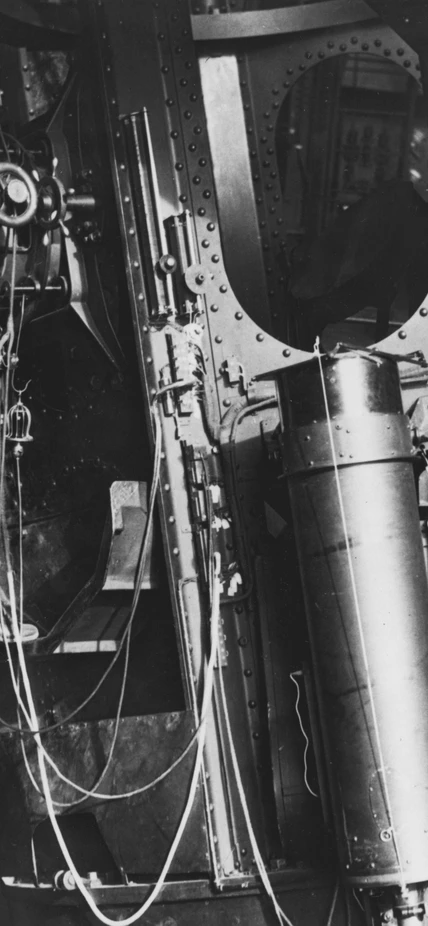Science is an iterative process. Collaborators present theories, test them, and build on the collective pool of knowledge to advance our knowledge of the natural world. But occasionally, a breakthrough arrives at specific, pinpointable eureka moment and the world can be forever divided into before and after.
This month, the Carnegie Observatories community celebrated the centennial of Edwin Hubble’s discovery of the greater universe. His breakthrough transformed astronomy and advanced humanity’s understanding of our place in the cosmos.
The landmark event was commemorated over the course of an action-packed weekend with a VIP program, the launch of a museum partnership, and the annual Observatories Open House.

In October 1923, Hubble used the 100-inch Hooker telescope at Mount Wilson Observatory to demonstrate that the Andromeda galaxy exists beyond the boundaries of our own Milky Way, throwing open the door to the cosmos.
His revelation was enabled by the detection of what’s called a Cepheid variable, a star that brightens and dims on a precise cadence. Just over a decade earlier, Harvard University human “computer” Henrietta Swan Leavitt demonstrated that these objects could be used to calculate astronomical distances thanks to the relationship between their brightness and the rate at which they pulse.
When Hubble found such a variable star in a cloud-like object that astronomers at the time were calling spiral nebulae, he was able to determine that it was too distant to be contained within the Milky Way, proving that the universe was bigger than just our galaxy.
The normally very staid Hubble was so excited when he saw the Cepheid star that he scrawled an exclamation point—VAR!—at the top of the glass plate on which the telescope images he’d taken were developed.

The festivities kicked off on the night of the anniversary with a VIP event for donors and friends at the Observatories. Guests mingled with hors d’oeuvres and cocktails, taking quick jaunts to explore a VAR! plate display in the library and check out activities in the machine shop, where instruments are custom built for the telescopes at Carnegie’s Las Campanas Observatory in Chile.
Then President Eric D. Isaacs and Observatories Director and Carnegie Deputy for Science John Mulchaey welcomed everyone to join them for a presentation about Hubble’s breakthrough, the science enabled by the space telescope that was named after him, and the discoveries that will be made by the next generation of extremely large telescopes that are currently under construction.
The next morning, Mulchaey and Carnegie astronomer Juna Kollmeier shared an overview of the past, present, and future of the field at the Los Angeles County Museum of Art. The program was precursor to the upcoming exhibit Mapping the Infinite: Cosmologies Across Cultures, which will include astronomical art and cosmological creations from around the world and explore questions about space, time, creation, and perception.
Mulchaey said the most important telescopes in recorded human history have been Galileo Galilei’s—which he used to make the first systematic inventory of the night sky, confirming the heliocentric model of the Solar System first proposed by Nicolaus Copernicus—the 100-inch telescope at Mount Wilson, and the Hubble Space Telescope.

We are still working on many of the questions that Copernicus and Galileo were, added Kollmeier, who leads the fifth generation of the Sloan Digital Sky Surveys and is the Director of the Canadian Institute for Theoretical Astrophysics, including: “What is our orientation in the cosmos, what is the composition of the cosmos, and what are the rules governing the cosmos. But we are poised to make big breakthroughs."
The busy weekend concluded with the annual Observatories Open House, which featured the VAR! plate as its theme this year. Mulchaey shared the story of the universe’s discovery repeatedly throughout the afternoon and guests of all ages participated in fun astronomy activities around campus, including virtual reality experiences, solar telescopes, constellation-themed crafts, and more.
The Carnegie community will continue to celebrate Edwin Hubble’s monumental discovery throughout 2024, closing the centennial with a program marking the day he finally reported his results to the American Astronomical Society on January 1, 2025.
